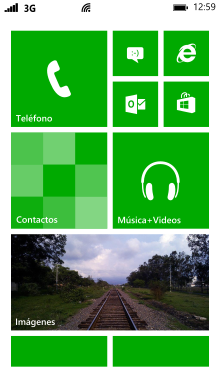现代UI
现代UI[1](英語:Modern UI),也称Metro UI[2]、Windows 8 Style UI,是微软一种界面设计語言,已被用于Windows Phone、Windows 8、Windows 10、Xbox 360等多款微软产品。[3][4]採用微软WP为此设计的標準字体。[3]在2012年Computex Taipei大会,微软确认此设计风格会用于Windows 8[5]和Office 2013上。[6]
 采用了Metro UI的Windows Phone 8开始界面 | |
| 開發者 | Microsoft |
|---|---|
| 首次发布 | 2010年 |
历史
编辑Metro是根據瑞士平面设计的设计原则,此设计的原则曾在Windows XP的Windows Media Center中体现,这有利于以文字为主的界面导航。2006年,Zune开始使用类似Metro的设计风格。微软的设计师计划重新设计现有用户界面、更清爽的排版和较少的重点以便于用户使用。[7]Zune的电脑端配套程序也使用了不同于以往Portable Media Center用户界面的清爽排版和设计。
2012年末,以“Metro”為名的公司麦德龙(Metro AG)聲稱微軟的介面Metro UI "Metro"一字已經侵權將要提告;後雖沒有提告,但微軟為了不再與該公司名稱衝突,決定取消"Metro"名稱,改用"Windows 8 Style UI"或者"Modern UI"取代了Metro UI,實質上是一樣的。
开发
编辑机场和地铁的指示牌给了微软设计团队灵感,其风格大量採用大字体,能吸引觀众之注意力。微软认为 Metro 设计主题应该是:“直覺、易懂、现代”。Modern的图标设计也会不同于Android和iOS。
使用於
编辑命名問題
编辑2012年8月,微軟的零售合作夥伴德國麥德龍(Metro AG)對軟件巨擘微軟的「Metro」商標侵權行為採取法律行動。一封要求停止使用「Metro」字眼直至代替字眼或案件結案的備忘錄亦被發送到軟件開發者和微軟員工。[9][10]
同月4日,電腦雜誌PC World報導,微軟將暫時稱其設計語言為「Windows 8 Style UI」,以填補「Metro」暫停使用期間的空白。[11]美國雜誌Wired的Alexandra Chang則建議微軟應直接使用「Windows 8」一詞,而非另選其他字眼。[12]
同月9日,微軟計劃在消費者市場使用「Windows 8」,而對計劃使用微軟新設計語言來開發軟件的開發人員則使用「Modern UI」。[13]
自2012年9月,「微軟設計語言(Microsoft design language)」開始被用到微软开发者网络的文件內[14][15][16][17] 以及Build年度會議[18][19]。
現時,微軟已經放棄了使用Metro風格(Metro-style)應用程序來形容根據微軟件設計語言來開發的Windows Runtime應用程序。同時,在正式使用Windows 8 apps這一名詞之前暫時使用Windows Store apps代替。[20]2019年,随着微软宣布流畅设计体系,Metro UI被正式抛弃。
参考文献
编辑- ^ DirectWrite 简介. [2017-01-28]. (原始内容存档于2017-02-02).
- ^ Clearing Up The Confusion: It’s “The New Windows 8 UI” – Not “Metro UI”. [2012-12-07]. (原始内容存档于2012-11-27).
- ^ 3.0 3.1 3.2 Windows Phone 7 Series UI Design & Interaction Guide. March 18, 2010 [2010-10-09]. (原始内容存档于2013-05-27).
- ^ E3: Xbox 360 getting TV tuner, Bing search, Metro interface. [2011-06-28]. (原始内容存档于2011-06-23).
- ^ 5.0 5.1 "Video: Windows 8 Uses WP7 Design, Runs from USB Stick" (页面存档备份,存于互联网档案馆). Published Friday 15 April 2011. Retrieved Friday 15 April 2011.
- ^ 6.0 6.1 Office 15 新界面泄漏:Modern UI 与新动画效果. [2011-06-28]. (原始内容存档于2011-03-18).
- ^ Windows Phone Design System: Codenamed ‘Metro’ (PDF). [2010-10-09]. (原始内容存档于2014-11-27).
- ^ 微软新版主页出现 Metro UI被引入. [2011-06-28]. (原始内容存档于2011-01-22).
- ^ Warren, Tom. Exclusive: Microsoft's Metro branding to be replaced 'this week' according to internal memo. The Verge (Vox Media). 2 August 2013 [29 May 2013]. (原始内容存档于2012-08-03).
- ^ Microsoft to drop 'Metro' name for Windows. BBC. 3 August 2012 [28 May 2012]. (原始内容存档于2013-05-26).
- ^ Bradley, Tony. Windows 8 'Metro' Is Dead, But UI Still Needs a Name. PC World. IDG. 4 August 2012 [10 August 2012]. (原始内容存档于2012-08-23).
- ^ Chang, Alexandra. Microsoft Doesn’t Need a Name for Its User Interface. Wired. Condé Nast. 8 August 2012 [28 May 2013]. (原始内容存档于2013-09-21).
- ^ McAllister, Neil. Microsoft: It was never 'Metro,' it was always 'Modern UI'. The Register. 10 August 2012 [28 May 2013]. (原始内容存档于2013-05-26).
- ^ Make great Windows Store apps. MSDN. Microsoft. [28 May 2013]. (原始内容存档于2013-05-26).
- ^ Design case study: iPad to Windows Store app. MSDN. Microsoft. [28 May 2013]. (原始内容存档于2013-05-26).
- ^ Guidelines for typography. MSDN. Microsoft. [28 May 2013]. (原始内容存档于2013-05-26).
- ^ Roadmap for Windows Store apps using DirectX and C++. MSDN. Microsoft. [28 May 2013]. (原始内容存档于2013-05-26).
- ^ The Microsoft design language. Channel9. Microsoft. [28 May 2013]. (原始内容存档于2013-05-26).
- ^ Foley, Mary Jo. Microsoft Design Language: The newest official way to refer to 'Metro'. ZDNet. CBS Interactive. [28 May 2013]. (原始内容存档于2013-05-26).
- ^ Microsoft finally comes clean(er) on post-Metro naming plans. ZDNet. CBS Interactive. 12 September 2012 [28 May 2013]. (原始内容存档于2012-09-13).
外部链接
编辑- UX guidelines for Windows Store apps (页面存档备份,存于互联网档案馆), Microsoft
- User Experience Design Guidelines for Windows Phone (页面存档备份,存于互联网档案馆), Microsoft